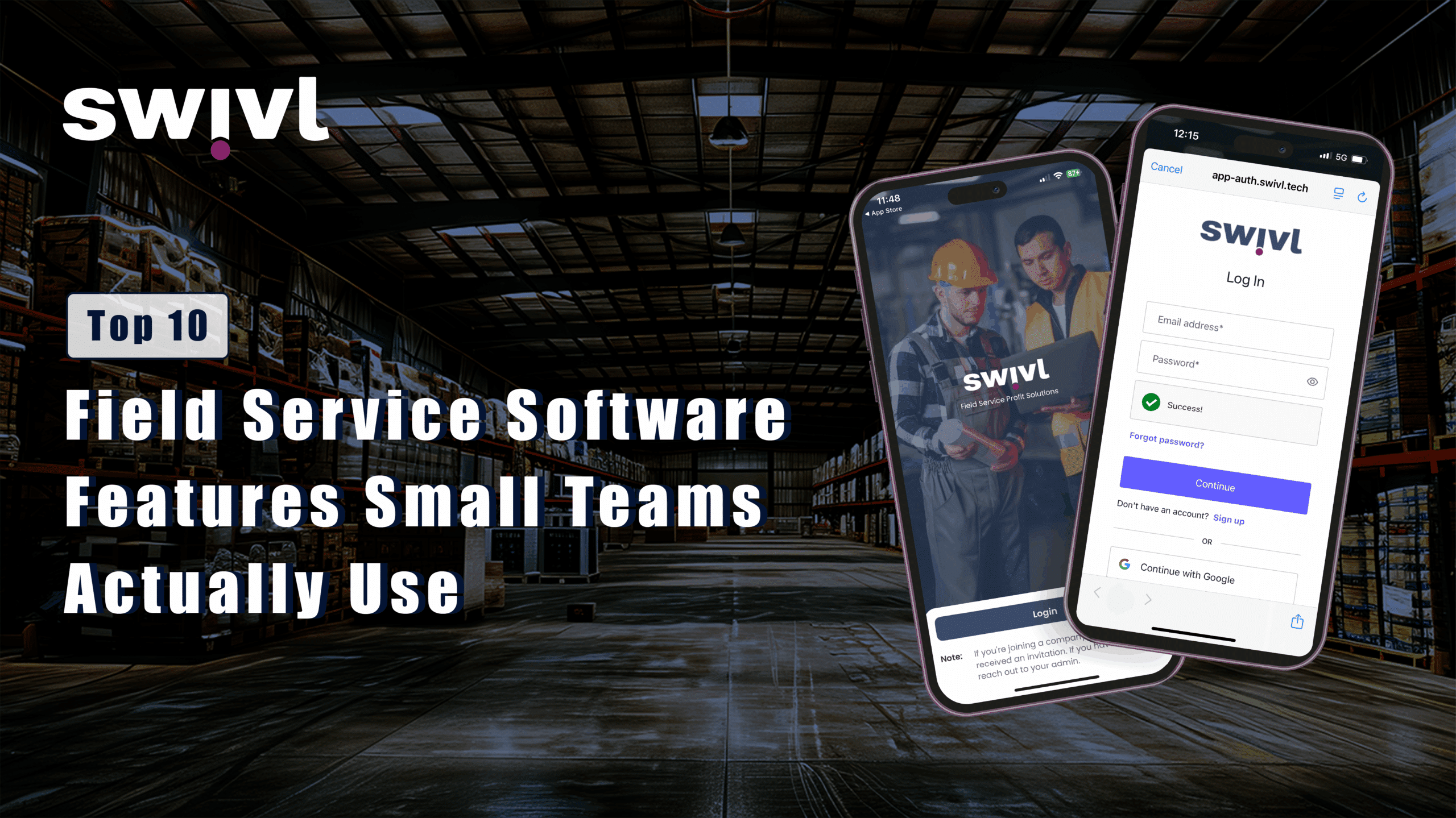Your plumbing business is growing. More customers call daily. Your scheduling system feels chaotic. You wonder if you need field service software for small business operations, but you’re not sure when to make the switch.
Here are five clear signs that manual processes are costing you money and holding back growth. If you recognize three or more of these situations, you’ve already waited too long to upgrade your systems.
Sign #1: You’re Double-Booking Appointments or Missing Jobs
The Problem Your receptionist manages appointments in a paper calendar or basic app. Technicians call asking about their next job. You accidentally book two customers at the same time slot. Customers wait at home while your team shows up at the wrong address.
These mistakes happen when appointment information lives in multiple places without real-time synchronization.
What This Costs You
-
- Lost revenue from missed appointments ($200-500 per incident)
-
- Overtime pay to reschedule displaced jobs
-
- Customer complaints and negative reviews
-
- Administrative time fixing scheduling conflicts
-
- Technician frustration and potential turnover
According to ServiceMax research, field service businesses lose an average of $50,000 annually to scheduling errors and missed appointments.
The Solution Field service management software provides centralized scheduling with real-time updates across all devices. When office staff books an appointment, technicians see it immediately on their mobile devices. Conflicts become impossible because the system prevents double-booking automatically.
Common signs you’re outgrowing manual systems include recurring scheduling problems, communication breakdowns, and increasing customer complaints.
Sign #2: Invoicing Takes Forever and Cash Flow Suffers
The Problem Your technicians complete jobs but invoices don’t get created for days or weeks. You use separate systems for scheduling, job tracking, and billing. Creating invoices requires gathering information from multiple sources, calculating costs manually, and printing/mailing physical documents.
Customers wait weeks to receive invoices, then pay 30-45 days later.
What This Costs You
-
- Delayed cash flow impacts working capital
-
- Administrative overhead creating invoices manually
-
- Lost revenue from forgotten or delayed billing
-
- Customer confusion about services performed
-
- Competitive disadvantage against faster-paying competitors
Field Service News reports that businesses using manual invoicing wait an average of 42 days longer for payment compared to those with automated systems.
The Solution Modern field service platforms generate invoices automatically when technicians complete jobs. Customers receive digital invoices immediately via email. Mobile payment processing allows on-site payment collection, reducing payment cycles from 45 days to 5 days.
Sign #3: You Can’t Track Technician Location or Job Progress
The Problem Customers call asking when your technician will arrive. You have no idea where your team members are or their progress on current jobs. Technicians call constantly with updates or questions. You can’t provide accurate arrival times to customers.
This lack of visibility creates customer service problems and operational inefficiencies.
What This Costs You
-
- Customer dissatisfaction from uncertain arrival times
-
- Office staff interruptions handling location questions
-
- Inability to optimize routes or reassign urgent jobs
-
- Poor customer experience compared to competitors
-
- Lost productivity from constant phone communication
The Solution Field service management tools provide real-time technician tracking and job status updates. GPS integration shows technician locations and estimated arrival times. Customers receive automatic notifications when technicians are en route.
Improve productivity with mobile FSM by implementing real-time tracking and communication systems.
Common FSM Transition Questions
How do I know if my business is ready for field service software? If you have 3+ technicians, schedule 15+ jobs weekly, or struggle with manual processes, you’re ready for field service management software. The efficiency gains justify the investment immediately.
What happens if I wait too long to implement FSM? Delayed implementation costs compound over time. You lose competitive advantage, customer satisfaction declines, and operational inefficiencies increase. Competitors using FSM tools will eventually price you out of the market.
Can small field service businesses afford FSM software? Quality field service software for small business starts around $30-50 per technician monthly. The time savings and efficiency gains typically pay for the software within 30-60 days.
Sign #4: Customer Information Is Scattered and Hard to Find
The Problem Customer details live in multiple places: phone numbers in one system, service history in another, billing information elsewhere. When customers call, you can’t quickly access their complete information. Technicians arrive without knowing customer preferences, equipment details, or service history.
This fragmentation creates poor customer experiences and operational inefficiencies.
What This Costs You
-
- Longer phone calls searching for customer information
-
- Technicians unprepared for jobs requiring specific parts or skills
-
- Missed opportunities for additional services or maintenance agreements
-
- Customer frustration from repeating information
-
- Inability to provide personalized service that builds loyalty
Research from Aberdeen Group shows businesses with centralized customer data achieve 27% higher customer retention rates and 19% more repeat business compared to those using fragmented systems.
The Solution Field service management platforms store all customer information in centralized profiles accessible from any device. Technicians see complete service history, equipment details, and customer preferences before arriving on-site. This preparation enables better service and identifies upselling opportunities.
Discover how Swivl helps small teams grow by centralizing customer data and streamlining operations.
Sign #5: You’re Working Longer Hours But Revenue Isn’t Growing Proportionally
The Problem Your business handles more service calls than ever, but profits aren’t increasing accordingly. You work 60+ hour weeks managing schedules, creating invoices, and handling administrative tasks. Your technicians seem busy but daily job completion hasn’t improved significantly.
Manual processes don’t scale efficiently with business growth.
What This Costs You
-
- Personal burnout from excessive administrative work
-
- Opportunity cost of time spent on manual tasks vs. sales activities
-
- Technician underutilization due to inefficient scheduling
-
- Competitive disadvantage against more efficient competitors
-
- Limited growth potential constrained by manual process bottlenecks
ServiceTitan’s 2024 State of Field Service report found that businesses using manual processes plateau at 70% technician utilization, while digitally-enabled companies achieve 85-90% utilization rates.
The Solution Field service management software automates administrative tasks, optimizes scheduling, and provides visibility into operations. You spend less time on paperwork and more time growing your business. Technicians complete more jobs daily through better routing and preparation.
Stay ahead of competitors with smarter tools that automate routine tasks and optimize operations.
Additional Warning Signs Your Business Needs FSM
Communication Breakdowns
-
- Technicians constantly calling for job details or schedule changes
-
- Customers calling to confirm appointments or check arrival times
-
- Office staff spending hours on phone coordination
-
- Important information getting lost between office and field teams
Quality Control Issues
-
- Inconsistent service delivery between technicians
-
- Missing documentation from completed jobs
-
- Difficulty tracking warranty work or follow-up requirements
-
- No visibility into first-time fix rates or customer satisfaction
Financial Management Problems
-
- Difficulty tracking job profitability by service type
-
- Unclear picture of technician productivity and efficiency
-
- Challenges managing inventory and parts costs
-
- Limited insight into business performance metrics
The Cost of Waiting
Every day you delay implementing field service management software, you lose money through:
Direct Financial Losses
-
- Missed appointments worth $200-500 each
-
- Delayed invoicing extending collection cycles
-
- Overtime costs from inefficient scheduling
-
- Lost customers due to poor service experiences
Competitive Disadvantage Your competitors using field service software complete more jobs, provide better customer service, and operate more profitably. The efficiency gap widens daily.
Growth Limitations Manual processes constrain growth. You can’t scale operations effectively without digital tools to manage complexity.
Making the Transition
Start with Core Functionality Begin with essential features like scheduling, mobile work orders, and basic invoicing. Add advanced capabilities as your team adapts to the new system.
Plan for Team Training Budget time for training office staff and technicians. Most teams adapt to modern field service software within 2-3 weeks with proper support.
Choose Scalable Solutions Select platforms that grow with your business. Avoid software that requires expensive upgrades or platform changes as you add technicians.
Measure Results Track key metrics before and after implementation:
-
- Daily jobs completed per technician
-
- Average invoice collection time
-
- Customer satisfaction scores
-
- Administrative time requirements
-
- Revenue per technician
Why Field Service Software Investment Makes Sense Now
- Technology Has Matured Modern field service platforms are user-friendly, affordable, and designed specifically for small businesses. Implementation is faster and easier than ever.
- Customer Expectations Have Changed Your customers expect digital convenience: appointment confirmations, arrival notifications, and digital invoices. Manual processes can’t deliver these experiences.
- Competitive Pressure Intensifies Businesses using field service management software gain significant advantages in efficiency, customer service, and profitability. You can’t compete long-term without similar tools.
- ROI Payback Is Fast Quality field service software typically pays for itself within 60-90 days through improved efficiency and faster cash flow.
Taking Action
If you recognize three or more signs from this list, your business needs field service management software immediately. The longer you wait, the more money you lose and the further behind competitors you fall.
Swivl Field Service Platform addresses all these pain points in one integrated solution:
-
- Centralized scheduling prevents double-booking and missed appointments
-
- Automated invoicing with mobile payments accelerates cash flow
-
- Real-time tracking provides complete operational visibility
-
- Unified customer database improves service quality
-
- Streamlined workflows reduce administrative overhead
Start evaluating field service software options today. Your business growth, profitability, and competitive position depend on making this transition before manual processes become completely unsustainable.
The signs are clear. The solution is available. The only question is how quickly you’ll implement the tools your business needs to thrive in today’s competitive market.




